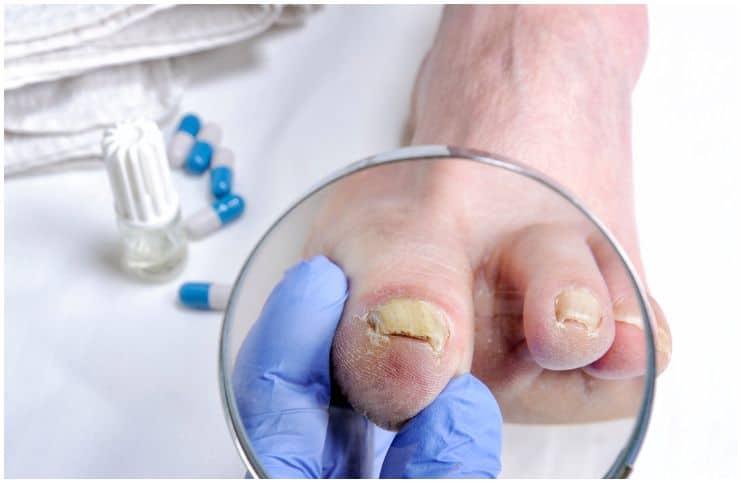Kerydin
It is the brand name of a generic drug called tavaborole, which belongs to a group of drugs known as antifungals.
The medication works by inhibiting an enzyme known as cytosolic leucyl-transfer RNA synthetase, that plays an essential role in fungal essential protein synthesis. This leads to the death of fungus.
It is produced by Anacor Pharmaceuticals, a company focused on developing novel small-molecule therapeutics. The US Food and Drug Administration originally approved this medication in 2014.
Uses
This prescription medication is indicated for onychomycosis of the toenail due to Trichophyton mentagrophytes or Trichophyton rubrum. It is the first oxaborole-class topical antifungal that can be used for onychomycosis.
Onychomycosis is a fungal infection that affects either the toenails or fingernails. It is the most common disease of the nails and constitutes about fifty percent of all nail abnormalities. According to statistics, about 10% of the adult population in the United States is affected.
Symptoms
You may have this condition if one or more of your nails are:
- smelling slightly foul;
- a dark color, caused by debris building up under the nail;
- distorted in shape;
- brittle, crumbly or ragged;
- whitish to yellow-brown discoloration;
- thickened.
Risk Factors
Factors which can increase your risk of developing onychomycosis include:
- having a weakened immune system;
- reduced blood flow;
- having type 2 diabetes mellitus;
- having a minor nail or skin injury;
- walking barefoot in damp communal areas, like – gyms, swimming pools, and shower rooms;
- having a history of athlete’s foot (tinea pedis);
- sweating heavily;
- being 65 or older.
Dosage
The medicine is applied topically to the affected toenail once per day. Continue using the medicine for the entire prescribed time even if the infection appears to be gone.
Notes – if your symptoms do not get better, call your healthcare provider. Before putting this antifungal on, clean the nails and dry well. Avoid trying to get the medicine on the skin which surrounds the treated toenail.
If you have accidentally applied the antifungal on the skin around the nail and other areas of the body, you can wash them with water and soap. Wash your hands with soap and water after applying this medicine.
Side Effects and Precautions
Side effects may include:
- redness, itching, and swelling;
- ingrown toenail;
- skin peeling.
Pregnancy & Breastfeeding
It is not known precisely whether this antifungal is excreted in human milk following topical application. Tell your doctor that you are breastfeeding a baby before using this medicine.
There are no well-done clinical studies to determine the safe use of this antifungal by pregnant women. Tell your doctor that you are pregnant before using this medicine.
Jublia
It is the brand name of a medication called efinaconazole that belongs to the class of medications called antifungal agents. It works by blocking the production of a compound known as ergosterol, that is found in the cell walls of fungi.
The medicine is produced by Valeant Pharmaceuticals, a multinational specialty pharmaceutical company with the headquarters in Laval, Canada. It was originally approved by the US FDA in June 2014.
Uses
This prescription medication is typically used to treat onychomycosis, a fungal infection of the toenails.
Note – the safety and effectiveness of this medicine in children has not been established, therefore, it might not be safe to apply this medication to children’s toenails.
Dosage
Apply this antifungal to affected toenails once per day for 48 weeks (about 11 months), using the integrated flow-through brush applicator.
Note – this antifungal is for topical use only and should not be applied to any other area of the body or taken orally. Do not use cosmetic nail products or nail polish while using this medicine.
Side Effects and Precautions
Common side effects may include:
- ingrown toenail;
- itching;
- pain or irritation where this antifungal was applied.
Rare side effects may include:
- severe itching, redness, or swelling of the affected toenail.
Drug Interactions
No significant interactions are known or found for this drug.
Pregnancy & Breastfeeding
It is not known exactly whether this topical antifungal passes into breast milk or if it could negatively affect an infant. Tell your healthcare provider if you are breast-feeding a baby.
Also, it is not known whether this medicine will harm an unborn baby. Tell your healthcare professional if you are pregnant or plan to fall pregnant while using this topical antifungal.
Bottom Line – Kerydin vs Jublia: Effectiveness & Costs
Kerydin (active ingredient – tavaborole) is an antifungal which is used to treat onychomycosis of the toenails due to Trichophyton mentagrophytes or Trichophyton rubrum. The average price for this topical antifungal is around $1,500.
In two clinical trials, fungal infection was eliminated using this medicine in 6.5 percent of the cases vs. 0.5 percent using the vehicle alone, and 27.5 percent vs. 14.6 percent using the vehicle alone.
Jublia (active ingredient – efinaconazole) is an antifungal medication which is used to treat onychomycosis, a fungal infection of the toenail. It is applied on, around, and under the nail to get to the site of infection. The average price for the most common version of this antifungal is around $575.
In one study, a complete cure was achieved in 17.8% of the patients after 48 weeks of efinaconazole applications. In the other study, 15.2% of the users achieved a cure after 48 weeks.
In conclusion, Kerydin is more efficient in the treatment of onychomycosis but also substantially more expensive.
References https://www.jubliarx.com/efficacy-side-effects https://www.sciencedirect.com/science/article/pii/S0190962215015121 https://www.kerydin.com/Using-Kerydin.aspx

